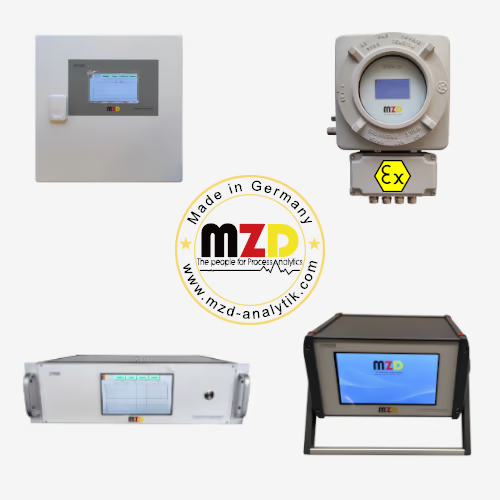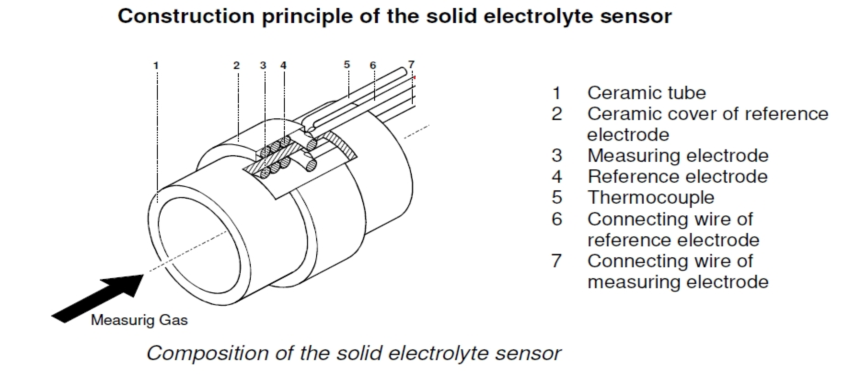
Oxygen analyzer principle and selection considerations
Oxygen analysis instruments can be generally classified into four categories according to different principles: electrochemical, Zirconia, paramagnetic oxygen, and laser methods.
1. Electrochemical principle
1.1 Fuel cell type
Also known as a galvanic cell, or a fuel cell, the sensor that consists of a cathode, anode and electrolyte. Oxygen enters the sensor filled with an electrolyte solution through a micro-hole in the polymer film of the sensor. When oxygen reaches the cathode, it is immediately reduced to release hydroxide ions: O2+ 2H2O + 4e-">4OH-
When these hydroxide ions pass through the electrolyte to the anode, an oxidation reaction occurs with the lead (anode) to produce the corresponding metal oxide: 2Pb + 4OH-">2PbO + 2H2O + 4e-
The above two reactions occur to generate current, and according to Faraday's principle, the current generated in the electrochemical reaction is determined by the number of oxygen molecules diffusing to the oxygen electrode, and the rate of oxygen diffusion is proportional to the oxygen content in the sample gas, independent of the total amount of gas passing through the sensor, thus allowing accurate measurement of the oxygen concentration.
It should be noted here that the new fuel cell is faster than the old "gold net - lead" primary cell oxygen measurement, and does not require a long start-up blowing process, the "gold net - lead" primary cell sample gas directly into the solution, resulting in a large amount of instrument maintenance, while the fuel cell The sample gas does not enter the solution directly, the sensor can work very stable and reliable for a long time, basically is maintenance-free. The sensor life is usually 1~3 years, and is generally used for oxygen content measurement at ppb, ppm, below air concentration (20.64%).
1.2 Constant potential electrolytic type
The working principle of the potentiometric electrolytic analyzer is to apply a specific potential to the electrode, and the gas under test becomes electrolytic on the surface of the electrode. By measuring the potential added to the electrode, the electrolytic potential specific to the gas under test can be determined, thus giving the instrument the ability to selectively identify the gas under test. The gas composition is measured based on the change in the amount of ions or the change in current caused by the chemical reaction. To improve selectivity, prevent tarnishing of the measurement electrode surface and maintain electrolyte performance, a diaphragm structure is generally used. Due to a combination of factors such as accuracy and reliability, it is generally used as an oxygen sensor for toxic and hazardous gas detectors and not as a sensor for oxygen content analysis instruments.
2. Zirconia principle
Zirconia (ZrO2) is a ceramic, doped with a certain percentage of low-valent metal oxides as stabilizers, such as calcium oxide (CaO), magnesium oxide (MgO), and yttrium oxide (Y2O3), it has high-temperature conductivity, a conductor with ionic conductive properties, and becomes a zirconia solid electrolyte. At a certain temperature, when the oxygen content in the gas on both sides of the zirconia tube is different, a typical oxygen concentration difference cell is formed.

The zirconia tube as a whole is tubular, separated by zirconia material, and a porous layer of metal is sintered on each side of the zirconia as an electrode (usually Pt is used as the electrode material). At a certain temperature (600℃~1400℃), oxygen molecules on the side with higher oxygen content are adsorbed on the electrode, making the electrode on that side positively charged and the positive or anode of the oxygen concentration difference battery. Under the catalytic action of platinum, a reduction reaction occurs and electrons are obtained to form oxygen ions. The oxygen ions migrate through the holes in the zirconia crystal to the other side where the oxygen content is lower, making that electrode negatively charged and the negative or cathode of the oxygen concentration cell. At the platinum electrode electrons are lost and oxygen molecules are formed. This creates a certain potential at the two electrodes due to the buildup of positive and negative charges, which is related to the difference in oxygen content concentration in the two measured gases of zirconia, in accordance with Nernst equation:
E=(RT/4F)*Ln(P0/P)
Where
E------- oxygen concentration difference potential (mV)
R------- gas constant 8.3145 J/mol-K
T------- zirconia probe operating temperature (K, absolute temperature) = 273.15 + t (°C)
F------- Faraday constant, 96485.3365 (C/mol)
P0------- partial pressure of oxygen in the reference gas
P ------- Oxygen partial pressure in the sample gas
The oxygen partial pressure (P) in the gas to be measured can be calculated by measuring the concentration cell potential E and the absolute temperature of the zirconia probe, and thus the oxygen concentration in the gas to be measured.
The zirconia method has high sensitivity, fast response time, wide linear range, good reproducibility and stability. The internal structure is simple and almost independent of external environmental conditions such as temperature, vibration, etc., and requires little maintenance. However, the zirconia method is not suitable for measuring oxygen concentration in reducing gases or gas samples with high reducing gas content because the oxygen concentration is affected by the reducing gas in the gas to be measured, resulting in low measurement results. The sensor life is typically 5 years or more and is typically used for oxygen content measurements at ppm, air concentration (20.64%).
Main applications of zirconia analyzer:
1. inert gas measurement of trace oxygen content, electronic semiconductor industry, air separation, steel metallurgy, chemical fertilizer, chemical industry, welding protection, etc.
2. flue gas measurement of percent oxygen content, power plants, petrochemical refining, chemical industry, iron and steel metallurgy, cement and building materials, boilers, etc.
3. Paramagnetic oxygen principle
3.1 Dumbbell
Oxygen is a paramagnetic substance and its volume magnetization rate can reach k=1062×10-6(C.G.S.M) at 20°C. The volume magnetization rate of other gases is much smaller compared to oxygen (except NO). The oxygen sensor is a pair of nitrogen-filled quartz glass dumbbell spheres with platinum wire wrapped around them to form an electrical feedback loop. The dumbbell spheres are suspended in a magnetic field and are equipped with a small reflector in the center. The instrument's built-in light source emits a light beam, which is reflected by the reflector and then received by a light detector made of a photosensitive component. When oxygen molecules are present around the dumbbell sphere, the oxygen molecules migrate under the action of the magnetic field, pushing the dumbbell sphere to deflect, the higher the oxygen concentration, the larger the deflection angle, this deflection will drive the mirror, so that the light path to the light detector also deflected. The light detector will measure this deflection and generate an electrical signal, which will be amplified by an amplifier and formed by a feed-back circuit to push the dumbbell back to the main equilibrium position under the action of a magnetic field. The current is directly proportional linear to the oxygen concentration in the measuring gas. By measuring the current value, the oxygen content of the sample can be obtained. The paramagnetic method for measuring oxygen content is basically independent of the non-detectable components of the gas sample (except NO and Xe), with fast response time, high accuracy and good stability. The pressure, dust, tar, water vapor, etc. in the sample can affect the measurement results and even damage the sensor. In addition, it is necessary to ensure that the instrument is placed horizontally, avoid vibration, strong magnetic fields, and there should be no equipment or power lines with large power around the instrument. Sensor life is usually more than 5 years, generally used for oxygen content concentration of high sample gas oxygen content (90% ~ 100%) measurement.
3.2 Thermoparamagnetic
As its magnetic susceptibility is approximately 100 times greater than that of most other common gases,and oxygen’s magnetic susceptibility varies inversely with temperature. Therefore, by carefully combining a magnetic field gradient and a temperature gradient within the measuring cell, an oxygencontaining gas mixture can be made to flow along these gradients. This induced gas flow is known as a magnetic wind. The intensity of this magnetic wind depends on the concentration of oxygen in the gas mixture.
One thermistor of each pair located inside the magnetic field and the other thermistor of each pair located outside the field. The bridge circuit becomes unbalanced as the electrical resistance of the thermistors changes with temperature. This circuit imbalance causes a voltage drop, which is proportional to the oxygen concentration in the gas being measured, to appear across the bridge circuit. This signal is proportional to the concentration of oxygen in the gas mixture.
4. Laser principle
Since oxygen molecules absorb laser light at a specific wavelength, a laser diode inside the instrument generates a laser beam of known intensity at a specific wavelength and shoots it into the measuring cell filled with the gas sample to be measured, which is reflected back and forth several times between two mirrors on both sides of the measuring cell.
According to Beer-Lambert law, the ratio between the intensity of the absorbed beam and the original light intensity is proportional to the oxygen content in the gas sample.
Ln(I0 / I ) = S * L * N
where
I0------- original light intensity
I------- residual light intensity after being absorbed by the oxygen in the gas sample
S------- Absorption constant of oxygen for a specific wavelength of laser light
L------- length of light range
N------- number of oxygen molecules on the optical range, depending on the oxygen content of the sample gas
Therefore the oxygen content in the gas sample can be obtained by measuring the original light intensity as well as the absorbed light intensity. Due to the specific laser wavelength selected, the measurement results are hardly influenced by other gases. The sensor has a typical lifetime of 5 years or more and is typically used for low concentration oxygen measurements at the percentage level in harsh environments.
